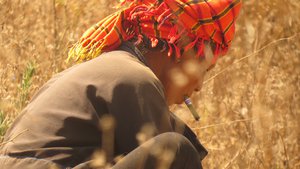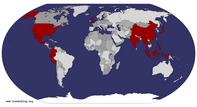Advertisement
Published: March 27th 2015

 Woman smoking cigar working in the field
Woman smoking cigar working in the field
Different tribes have different coloured headscarfsOur 3 day trek through the mountains of Myanma: We did not know this at the time, but this was to become one of the main highlights of our trip to Myanmar.
We made a quick stop in Kalaw which was pretty uneventful but the purpose of which was to book and begin a 3 day 2 night trek from Kalaw to Inle Lake. We happily took the day bus option to get here as opposed to any night bus, although arriving in the daytime still made no difference. Following an 8 hour ride we were both disoriented, tired and restless. In minutes however we settled on Honey Pine Inn and were pretty happy with the hotel. Using P’s bartering skills we managed to get a $35 room to $20, and it was the best room we’ve had in Myanmar by far. Still paired up with Beatrice and Trudy (pronounced Trouda) from the island hopping tour in Bagan we went on the search for a suitable trekking company. After 4 mind boggling sale pitches we agreed on the Sam’s Trekking Company.
With hardly any sleep due to our pre trek excitement (which in hindsight was silly as the following

 Rice paddies during dry season
Rice paddies during dry season
They look a lush green during wet season2 nights were also sleepless) we packed our day packs, secured our backpacks and off we went to the tour company. Not before a big tasty breakfast.
Once we arrived at the centre we were greeted by the 4 other group members; Beatrice (from Germany) Trudy (Austria), Ken (USA) his girlfriend Joyce (Brazil), oh and not forgetting our smiling guide Cookie.
We have to say that the trek was one of the most amazing things we have ever done. We trekked to places that were absolutely stunning and with scenery that varied every time you took your eyes off the path to look around you. From the dusty sand desert like terrains, to lush forests, cultivated slopes, the mountainous limestone peaks and the picturesque cascading rice paddies. We saw it all. The scenery was amazing and all untouched by any development. No high rises in sight or concrete structures. Just small wooden traditional single or 2 story structures.
Rather than going on a trail whereby local village life had been set up for tourism, we really felt like we had an authentic experience. We were able to walk through villages and farmed land and witness everyday life
without interfering or without feeling that the locals had been asked to interact with us. This was an experience that we will remember for a lifetime. Watching local village life was surreal, we felt gifted and blessed to have this opportunity. We walked past women in the steep mountains either ploughing, sowing seeds or cultivating crop, no matter what time of day or how scorching the sun was. Young boys herding cows and water buffaloes. Instead of having machinery these cows were used to plough rice paddies or cultivate land to start the cycle again.
Men were less seen but when they were seen they either creating masonry bricks out of limestone for towns and cities, building new structures, setting fires to fertilise land again or riding cow drawn carriages to transport wood. It was interesting to hear about how their roles changed according to the wet and dry seasons; with more work needed in the wet season but still with 12 hours of mannual labour necessary in the dry season. These people worked hard to make ends meet. This made us all think about the luxuries we have back home; the basic necessities we have, yet the common
desire to want more. The focus here was making it through the season and providing for the family, nothing more nothing less.
All the field work left many of the older women permanently hunched over which was difficult to see but it never appeared to stop them; like our home stay house owner who was up and about at all times of day despite her severe back disfigurement. Another interesting thing we learnt about on the trek was how different tribes will grow different crops, mainly ginger, potatoes, corn, water rice, mountain rice, turmeric and mustard seed. For us it was lovely to hear that they all worked together in that sense and then came together to sell their goods at the nearby train station without any argument. Now that’s teamwork. We actually got to witness the market at the train station on the first day, which was amazing sight as the traders went into action as soon as the train pulled in.
As we walked through local land we heard all about the culture within the tribes which was fascinating, from the arranged marriages within the villages to the monk novice ceremonies meant for young boys and

 Mother and daughter working together
Mother and daughter working together
Our guide kindly translated conversations for usgirls spending at least a month or two in training. Small shrines were not too difficult to find and small animals such as chickens, pigs and cows littered the land.
Day one of the trek followed a nice gradual incline which allowed the group to socialise and get to know each other a little better. I think we landed a lovely group, being the only ones from England and the youngest in the group. We all had in common a desire to travel and see the world, which helped the many conversations that followed. One thing that hit the group was the intensity of the scorching sun during midday. For many, this was difficult during the exposed hours but was then made easy in the second half that had cover in the forested areas.
During day 2 of the trek P’s worst nightmare actually happened, okay slight exaggeration but anyway… we saw a snake. Cookie & Beatrice who were in front at the time nearly stepped on it but fortunately the snake slid away in time (abandoning its meal) leaving everyone unharmed and slightly giddy from the excitement afterwards. Not sure whether it was venomous or not but

 Group of young boys armed with catapults
Group of young boys armed with catapults
They were happy to show off there aim..at trees, not usfor description’s sake it was green and about 1.5m. EEK. I think everyone jumped, suffice to say we all watched our steps for the final 2 hours of that day's trek.
Tired, exhausted and hungry, most nights we would arrive at our home stay just before sunset. A traditional homestay that is. Most of these houses are organised into an open plan sleeping quarter on the first floor while the kitchen (small fire stove) and the animal storage area is all below. Dreading the cold night ahead we all washed with the ice cold bucket water whilst it was still daylight and added layers on quickly afterwards. Before bed on one night Cookie shared a video of a firework festival the villagers have once a year – the festival mainly consisted of lots of alcohol and even more fireworks. This took us all by surprise, the level of safety was questionable to say the least!!!
Sorry, back to the trek; throughout the trek the food was a highlight and something we started to look forward to more and more. For lunch on the first day we were served an avocado salad, chapatti's, soup, rice and strawberries. The food
was tasty and plentiful taking us all by surprise. Dinner never disappointed either with an array of vegetable dishes, a chicken dish, rice and soup. The food varied by day but turned out to be some of the most amazing local dishes we had in Myanmar (Burma).
In total, we believe the whole 3 day trek followed a gruelling 64 kilometre trail often up and down sometimes leaving us breathless and achy after the days trek. The first day covered 24km, the second 22km and the third 17km. For P the first day was the hardest as walking 9 hrs with breaks (so about 7 hours without breaks) was difficult to start off with but Chris found the second day the hardest that took 10 hrs in total, waking up for 5.30am and leaving for 6am. In truth when 5:30 arrived and we were woken up by our smiling guide saying “good morning” we sneakily covered our heads, pretending not to hear. It was one of those mornings that we wished we could wake up later. One strange thing we have noticed about travelling is that although we are out of work, we seem to be waking up at
earlier hours than we did back home when working. Shouldn't it be the opposite? Anyway, we both agreed the views were worth it when we finally made it out of bed and onto the trail. Just watching the sun rise over the mountains was both powerful and humbling. The experience had the whole group quiet as we all tried to take it in.
our homestay's were delightful and we were all made to feel truly welcomed. Along with basic bathing, the toilet consisted of a small spider filled cabin with a squat hole. We expected nothing more than this so it didnt cause any problems. One thing that did hit us hard though were the cold temperatures at night. The two of us were not prepared for it and so shivered our way through the sleepless night. With the temperature reaching highs of 30's during the day the lows of 5 during the night were difficult. It was cold enough to clearly see our breath. Always a good indicator of the cold temperatures. For us, we would say that this was the most difficult thing but it didn't dampen our experience at all.
Overall, we felt that
the trek was a truly local cultural experience made possible by the tour agency using smaller groups (up to 6) with the company building relationships with local villagers but not interrupting their way of life for the purpose of tourism. Our only fears is that with more tourism these local traditions will fade and become interrupted by mass unfriendly tourism, ruining culture, traditions and the land (that provided little to no road access as we walked the beaten local paths, fields and paddies). These people work hard and their life is dictated by the land, daylight, season and cultural traditions. They are also very happy and work together. Something built up urbanised areas have lost and try to strive for. They also do not seek tourism but are friendly enough to allow it to happen as long as it does not disturb local life and culture. So if you are thinking about choosing a trekking agency make sure you consider their ethos. Sam’s trekking agency comes highly recommended by us.
Advertisement
Tot: 0.062s; Tpl: 0.022s; cc: 16; qc: 27; dbt: 0.0308s; 1; m:domysql w:travelblog (10.17.0.13); sld: 1;
; mem: 1.1mb





























taracloud
Tara Cloud
Off the beaten path!
What a magical experience to experience authentic rural life! So often I've seen men in villages hanging out in cafes while the women did all the work. How wonderful that here, everyone pitched in, cooperated and were happy. Bravo for you for walking those very long distances, even in the sun, and getting to witness such beauty! Thanks for taking us along.